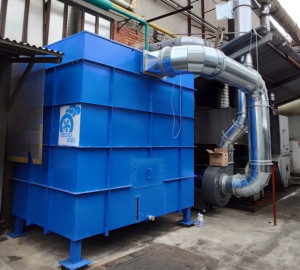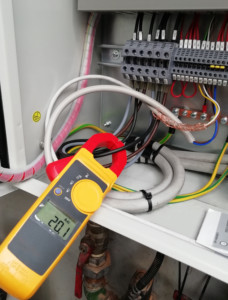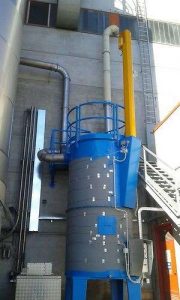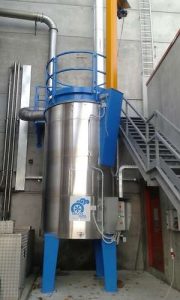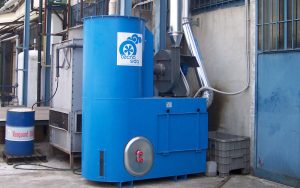Oil mist and oil vapor filtration plant
Suction and abatement of oil mist
Application 1: Development of the system on the annealing heat treatment
Today we will talk about a company which has been dealing with heat tempering for decades now. This process is used to alter the physical and chemical properties of materials.
Tempering is the most known process and it is used to increase the surface hardness of steel.
The customer has contacted us asking for our intervention exactly on annealing steel process, which involves the emission of hot oil fumes. As a matter of fact, these fumes contain oil steam originating from the immersion of metal pieces in tanks full of synthetic oil. Already before our intervention, the company’s production site had a treatment system which extracted the hot fumes funnelling them through a wet scrubber which should have reduced the oil part.
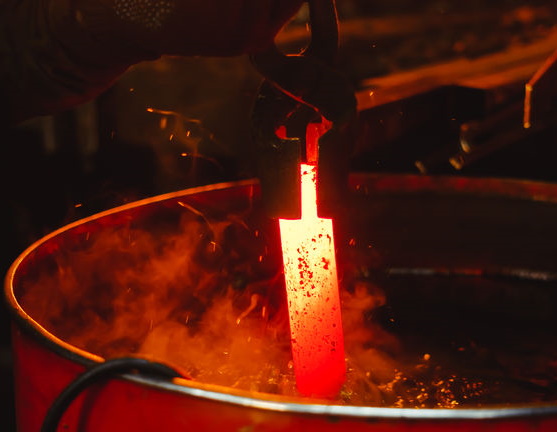
However, the solution adopted at the time did not respect the emission limits in the atmosphere set by the authorities (in this case, defined in 10 mg / Nm3 for the oil mist). Therefore, the customer has contacted Tecnosida® in order to solve this problem.
Hot fumes extraction and oil mist filtration
At the end of this first stage, Tecnosida® proposed the installation of a coalescing filter after the wet scrubber, in order to reduce the oil mist, as the prior system did not filter them.
Tecnosida® has presented a technology which reduces the oil mist through the coalescence basics of physics: it allows the micro particles in the gas flow to join together in order to create bigger oil drops, which fall on the bottom of the filter, due to gravity, where they are gathered. Therefore, thanks to this system, the oil can be recovered (it can be reused avoiding waste) and air flow without pollutant can be emitted in the atmosphere.
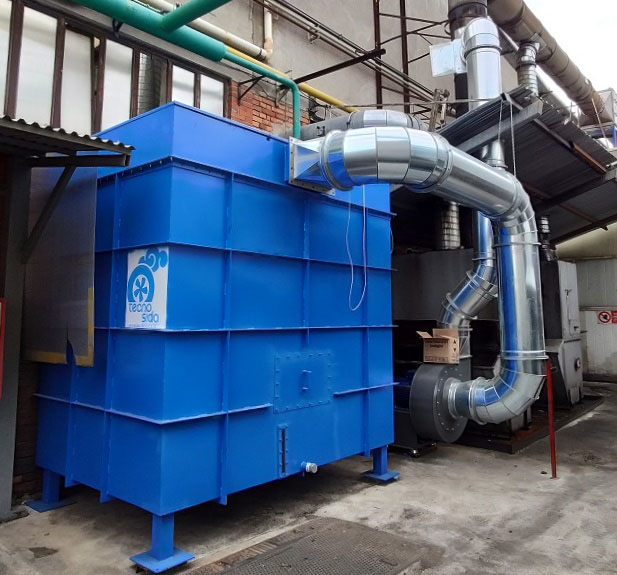
In order to facilitate the incorporation of oil particles, a special filter surface composed of glass fibre cartridges has been used. Depending on their size, shape and specific weight, the oil drops can get together through different processes:
- Sieve = the air flow passes through the filter fibres and the roughest particles are stopped between the two fibres as they have a greater diameter than the distance between the fibres themselves;
- Collision = due to its inertia, the particle moves forward and collides with the fibre adhering to it due to the viscosity of the oils which treated and soaked the fibres;
- Brownian motion = a phenomenon that consists in the fact that the sub micron particles (in particular, those that have a diameter less than 1 micron) have their own oscillation movements which are much higher the smaller the particle size. The molecules come into contact with the filter fibres during these movements: the chances that the particles come into contact with the filter fibre increase as long as the diameter of the particles and fibres and the air speed decrease. The particles adhere to the fibres as a result of elementary electric forces (static electricity). The process of diffusion occurs in the filters with very high efficiency.

Efficiency of the filter for oil mist
The coalescing separator filter has been produced according to the specific needs of the customer and the production process, taking into consideration plant’s capacity and temperature.
The implemented technology has confirmed its high filtration efficiency (99,99%): thanks to this, the number of oil particles decreased, including those little ones that could not be filtered by the existing wet system.
The tests carried out by the customer have proved this result:
- before the implementation of the mist filtration system, they showed a concentration of oil particles in the amount of 27 mg/Nm3
- after having implemented the Tecnosida® coalescence technology, they reported less than 2 mg/Nm3 concentration
Therefore, the adopted solution has completely solved the customer’s problem. Thanks to this, the values remained under 10 mg/Nm3, provided for by law.
Application 2: production and use of synthetic monomers
The customer is a leading company in the production of non-woven fabric (TNT – NONWOVEN) for various uses, including personal hygiene, industrial use, clothing, wallpapers, agriculture, etc.
In short, NONWOVEN, instead of being woven on a loom, is made of a polymer (generally polypropylene / PP or polyester / PET) which is melted, spun and distributed as a continuous thread by extruders in such a way that the threads cross each other in a random manner. Finally, a heated cylinder (roll stack) makes the fibres bind together and gives them the characteristic square or oval “pitting” that makes the fabric soft and at the same time durable.
During the production process, synthetic monomers such as polypropylene are used at high temperature, creating emissions that can be defined “polymeric vapours”, or oily mist emissions that are difficult to treat as their physical properties change with the temperature.
Plant for the removal of polymeric vapors:
Tecnosida® proceeds to the technical inspection at the customer’s site and, once the problems and the peculiarities present in the production process are highlighted, proposes the construction of a plant specifically designed according to company needs and composed of:
- Oilscreen® filter with coalescing technology, which includes:
- filtering chamber for the containment of the cartridges and differential pressure switch;
- lower tank for collecting oily condensate
It is equipped with a temperature regulator and special insulation, in order to minimize the impact of the cold winter temperatures on the physical state of the effluent to be treated. In particular, the insulation was made of rock wool with a thickness suitable to avoid the phenomenon of condensation and was applied to all the parts exposed to the external environment (filter and pipe);
- External oil-tight pipe, made of Aisi 304 stainless steel, flanged and insulated for the introduction of the air flow to be treated;
- Installation of a jib hoist for the maintenance / replacement of coalescence filtering cartridges with total weight, in the operation phase, exceeding 250 kilograms each.
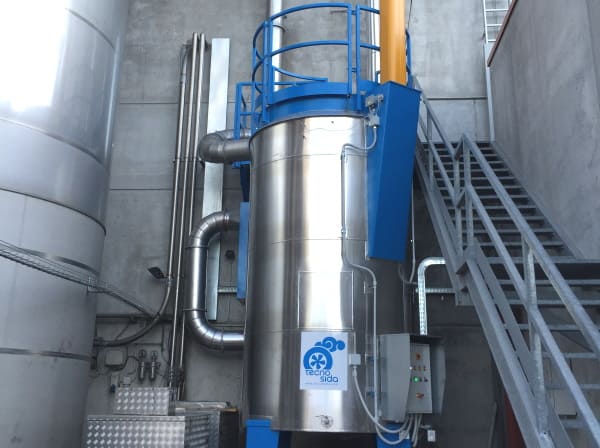
The filter has been realized in the version for outdoor use in low temperature environments. Tecnosida® plant is realized in compliance with the BAT (DC.CF.01). It reduces the emissions within the limits established by law, solving the problem of our customer.
Application 3: metal treatment
The customer of this third application operates in the same sector analyzed in the first application. It was one of the first Italian companies to adop vacuum technology in the heat treatment sector. The company performs treatments of: steel hardening, brazing, sintering, plasma nitriding, surface hardening, annealing and PVD coating processes. The main fields of application are sectors such as aeronautics, underwater equipment, racing, gas turbines, molds and food.
As we have seen, thermal and thermo-chemical treatments performed on metals involve the emission of oil vapours: in the specific case, emission into the atmosphere is equal to 20mg/Nm3. Tecnosida® was contacted to solve this situation by designing a plant able to connect and interact with their existing treatment system (located on the factory roof).
Coalescence filter for oil mists abatement:
Tecnosida®, after adequate technical inspection, recommended the installation of an Oilscreen filter that uses the coalescencing filtration technology seen above.
The main advantages of the system realized for our customer are:
- high filtration efficiency;
- external insulation that avoids the phenomenon of condensation;
- recovery of the pollutant;
- resistance over time;
- compactness
In this application the system was realized in a portable versione to meet the customer’s needs.
This solution is suitable for reduced flow rates and allows to move the filtration system from one machine to another according to use. Tecnosida® plant is realized in compliance with BAT (DC.CF.01). It reduces the emissions within the limits established by law, solving the problem of our customer.
